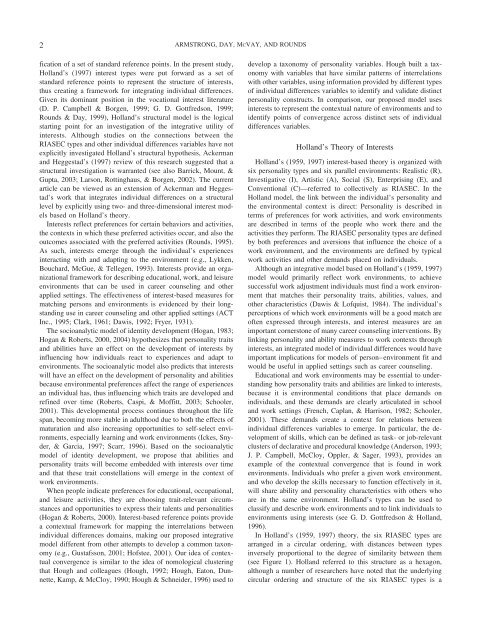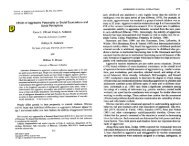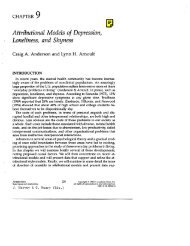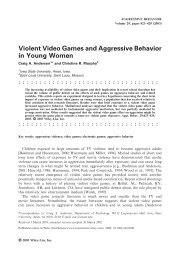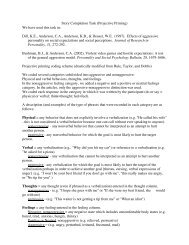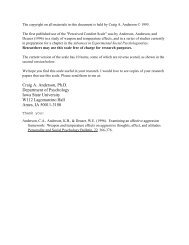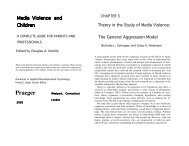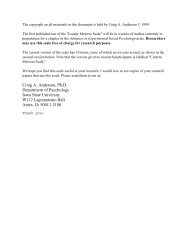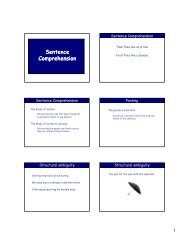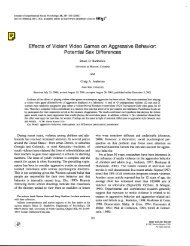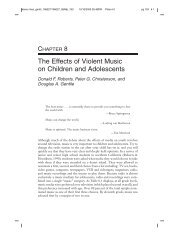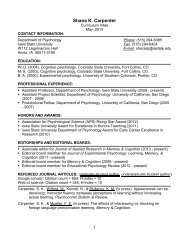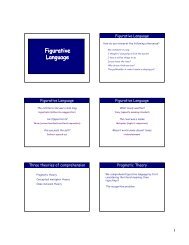Holland's RIASEC Model as an Integrative Framework for Individual ...
Holland's RIASEC Model as an Integrative Framework for Individual ...
Holland's RIASEC Model as an Integrative Framework for Individual ...
Create successful ePaper yourself
Turn your PDF publications into a flip-book with our unique Google optimized e-Paper software.
2 ARMSTRONG, DAY, MCVAY, AND ROUNDS<br />
fication of a set of st<strong>an</strong>dard reference points. In the present study,<br />
Holl<strong>an</strong>d’s (1997) interest types were put <strong>for</strong>ward <strong>as</strong> a set of<br />
st<strong>an</strong>dard reference points to represent the structure of interests,<br />
thus creating a framework <strong>for</strong> integrating individual differences.<br />
Given its domin<strong>an</strong>t position in the vocational interest literature<br />
(D. P. Campbell & Borgen, 1999; G. D. Gottfredson, 1999;<br />
Rounds & Day, 1999), Holl<strong>an</strong>d’s structural model is the logical<br />
starting point <strong>for</strong> <strong>an</strong> investigation of the integrative utility of<br />
interests. Although studies on the connections between the<br />
<strong>RIASEC</strong> types <strong>an</strong>d other individual differences variables have not<br />
explicitly investigated Holl<strong>an</strong>d’s structural hypothesis, Ackerm<strong>an</strong><br />
<strong>an</strong>d Heggestad’s (1997) review of this research suggested that a<br />
structural investigation is warr<strong>an</strong>ted (see also Barrick, Mount, &<br />
Gupta, 2003; Larson, Rottinghaus, & Borgen, 2002). The current<br />
article c<strong>an</strong> be viewed <strong>as</strong> <strong>an</strong> extension of Ackerm<strong>an</strong> <strong>an</strong>d Heggestad’s<br />
work that integrates individual differences on a structural<br />
level by explicitly using two- <strong>an</strong>d three-dimensional interest models<br />
b<strong>as</strong>ed on Holl<strong>an</strong>d’s theory.<br />
Interests reflect preferences <strong>for</strong> certain behaviors <strong>an</strong>d activities,<br />
the contexts in which these preferred activities occur, <strong>an</strong>d also the<br />
outcomes <strong>as</strong>sociated with the preferred activities (Rounds, 1995).<br />
As such, interests emerge through the individual’s experiences<br />
interacting with <strong>an</strong>d adapting to the environment (e.g., Lykken,<br />
Bouchard, McGue, & Tellegen, 1993). Interests provide <strong>an</strong> org<strong>an</strong>izational<br />
framework <strong>for</strong> describing educational, work, <strong>an</strong>d leisure<br />
environments that c<strong>an</strong> be used in career counseling <strong>an</strong>d other<br />
applied settings. The effectiveness of interest-b<strong>as</strong>ed me<strong>as</strong>ures <strong>for</strong><br />
matching persons <strong>an</strong>d environments is evidenced by their longst<strong>an</strong>ding<br />
use in career counseling <strong>an</strong>d other applied settings (ACT<br />
Inc., 1995; Clark, 1961; Dawis, 1992; Fryer, 1931).<br />
The socio<strong>an</strong>alytic model of identity development (Hog<strong>an</strong>, 1983;<br />
Hog<strong>an</strong> & Roberts, 2000, 2004) hypothesizes that personality traits<br />
<strong>an</strong>d abilities have <strong>an</strong> effect on the development of interests by<br />
influencing how individuals react to experiences <strong>an</strong>d adapt to<br />
environments. The socio<strong>an</strong>alytic model also predicts that interests<br />
will have <strong>an</strong> effect on the development of personality <strong>an</strong>d abilities<br />
because environmental preferences affect the r<strong>an</strong>ge of experiences<br />
<strong>an</strong> individual h<strong>as</strong>, thus influencing which traits are developed <strong>an</strong>d<br />
refined over time (Roberts, C<strong>as</strong>pi, & Moffitt, 2003; Schooler,<br />
2001). This developmental process continues throughout the life<br />
sp<strong>an</strong>, becoming more stable in adulthood due to both the effects of<br />
maturation <strong>an</strong>d also incre<strong>as</strong>ing opportunities to self-select environments,<br />
especially learning <strong>an</strong>d work environments (Ickes, Snyder,<br />
& Garcia, 1997; Scarr, 1996). B<strong>as</strong>ed on the socio<strong>an</strong>alytic<br />
model of identity development, we propose that abilities <strong>an</strong>d<br />
personality traits will become embedded with interests over time<br />
<strong>an</strong>d that these trait constellations will emerge in the context of<br />
work environments.<br />
When people indicate preferences <strong>for</strong> educational, occupational,<br />
<strong>an</strong>d leisure activities, they are choosing trait-relev<strong>an</strong>t circumst<strong>an</strong>ces<br />
<strong>an</strong>d opportunities to express their talents <strong>an</strong>d personalities<br />
(Hog<strong>an</strong> & Roberts, 2000). Interest-b<strong>as</strong>ed reference points provide<br />
a contextual framework <strong>for</strong> mapping the interrelations between<br />
individual differences domains, making our proposed integrative<br />
model different from other attempts to develop a common taxonomy<br />
(e.g., Gustafsson, 2001; Hofstee, 2001). Our idea of contextual<br />
convergence is similar to the idea of nomological clustering<br />
that Hough <strong>an</strong>d colleagues (Hough, 1992; Hough, Eaton, Dunnette,<br />
Kamp, & McCloy, 1990; Hough & Schneider, 1996) used to<br />
develop a taxonomy of personality variables. Hough built a taxonomy<br />
with variables that have similar patterns of interrelations<br />
with other variables, using in<strong>for</strong>mation provided by different types<br />
of individual differences variables to identify <strong>an</strong>d validate distinct<br />
personality constructs. In comparison, our proposed model uses<br />
interests to represent the contextual nature of environments <strong>an</strong>d to<br />
identify points of convergence across distinct sets of individual<br />
differences variables.<br />
Holl<strong>an</strong>d’s Theory of Interests<br />
Holl<strong>an</strong>d’s (1959, 1997) interest-b<strong>as</strong>ed theory is org<strong>an</strong>ized with<br />
six personality types <strong>an</strong>d six parallel environments: Realistic (R),<br />
Investigative (I), Artistic (A), Social (S), Enterprising (E), <strong>an</strong>d<br />
Conventional (C)—referred to collectively <strong>as</strong> <strong>RIASEC</strong>. In the<br />
Holl<strong>an</strong>d model, the link between the individual’s personality <strong>an</strong>d<br />
the environmental context is direct: Personality is described in<br />
terms of preferences <strong>for</strong> work activities, <strong>an</strong>d work environments<br />
are described in terms of the people who work there <strong>an</strong>d the<br />
activities they per<strong>for</strong>m. The <strong>RIASEC</strong> personality types are defined<br />
by both preferences <strong>an</strong>d aversions that influence the choice of a<br />
work environment, <strong>an</strong>d the environments are defined by typical<br />
work activities <strong>an</strong>d other dem<strong>an</strong>ds placed on individuals.<br />
Although <strong>an</strong> integrative model b<strong>as</strong>ed on Holl<strong>an</strong>d’s (1959, 1997)<br />
model would primarily reflect work environments, to achieve<br />
successful work adjustment individuals must find a work environment<br />
that matches their personality traits, abilities, values, <strong>an</strong>d<br />
other characteristics (Dawis & Lofquist, 1984). The individual’s<br />
perceptions of which work environments will be a good match are<br />
often expressed through interests, <strong>an</strong>d interest me<strong>as</strong>ures are <strong>an</strong><br />
import<strong>an</strong>t cornerstone of m<strong>an</strong>y career counseling interventions. By<br />
linking personality <strong>an</strong>d ability me<strong>as</strong>ures to work contexts through<br />
interests, <strong>an</strong> integrated model of individual differences would have<br />
import<strong>an</strong>t implications <strong>for</strong> models of person–environment fit <strong>an</strong>d<br />
would be useful in applied settings such <strong>as</strong> career counseling.<br />
Educational <strong>an</strong>d work environments may be essential to underst<strong>an</strong>ding<br />
how personality traits <strong>an</strong>d abilities are linked to interests,<br />
because it is environmental conditions that place dem<strong>an</strong>ds on<br />
individuals, <strong>an</strong>d these dem<strong>an</strong>ds are clearly articulated in school<br />
<strong>an</strong>d work settings (French, Capl<strong>an</strong>, & Harrison, 1982; Schooler,<br />
2001). These dem<strong>an</strong>ds create a context <strong>for</strong> relations between<br />
individual differences variables to emerge. In particular, the development<br />
of skills, which c<strong>an</strong> be defined <strong>as</strong> t<strong>as</strong>k- or job-relev<strong>an</strong>t<br />
clusters of declarative <strong>an</strong>d procedural knowledge (Anderson, 1993;<br />
J. P. Campbell, McCloy, Oppler, & Sager, 1993), provides <strong>an</strong><br />
example of the contextual convergence that is found in work<br />
environments. <strong>Individual</strong>s who prefer a given work environment,<br />
<strong>an</strong>d who develop the skills necessary to function effectively in it,<br />
will share ability <strong>an</strong>d personality characteristics with others who<br />
are in the same environment. Holl<strong>an</strong>d’s types c<strong>an</strong> be used to<br />
cl<strong>as</strong>sify <strong>an</strong>d describe work environments <strong>an</strong>d to link individuals to<br />
environments using interests (see G. D. Gottfredson & Holl<strong>an</strong>d,<br />
1996).<br />
In Holl<strong>an</strong>d’s (1959, 1997) theory, the six <strong>RIASEC</strong> types are<br />
arr<strong>an</strong>ged in a circular ordering, with dist<strong>an</strong>ces between types<br />
inversely proportional to the degree of similarity between them<br />
(see Figure 1). Holl<strong>an</strong>d referred to this structure <strong>as</strong> a hexagon,<br />
although a number of researchers have noted that the underlying<br />
circular ordering <strong>an</strong>d structure of the six <strong>RIASEC</strong> types is a


